Tahoe W ildfire
PREPAREDNESS GUIDE 2023
INSIDE
PREPARE YOUR FAMILY
WILDFIRE EVACUATION CHECKLIST
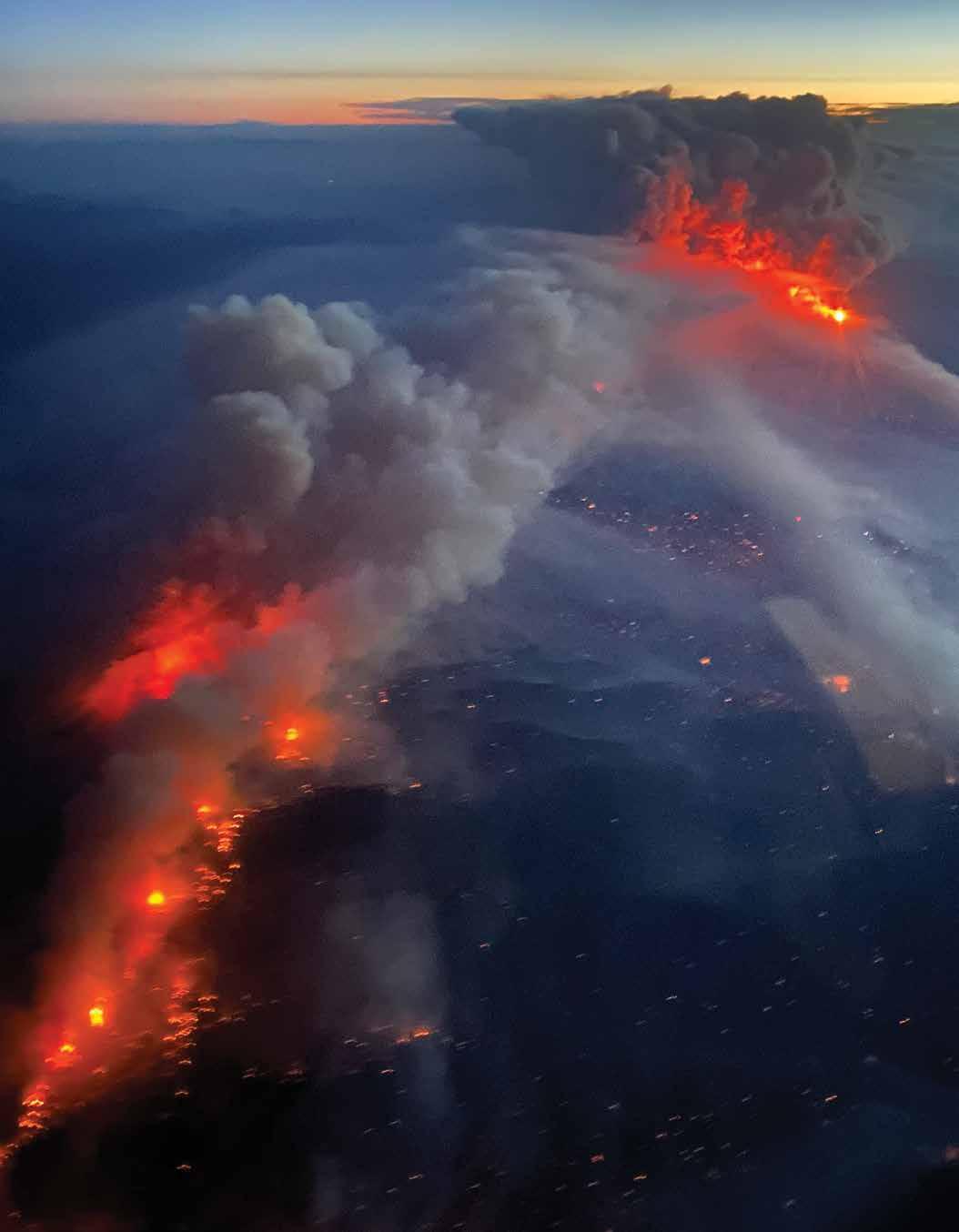
PREPARE A GO BAG
DEFENSIBLE SPACE FOR YOUR HOME
UNDERSTAND FIRE WARNINGS BE EMBER AWARE PREPARE YOUR HOME HOME RETROFIT GUIDE EVACUATION SIGN DOWNLOAD OUR DIGITAL GUIDE FOR PRINTABLE CHECKLISTS & MORE INFORMATION AT: issuu.com/TheTahoeWeekly
Aerial view of the Caldor Fire 2021 | Courtesy CalFire 3 RD ANNUAL
Prepare Your Family for a Wildfire
Residents and visitors need to be prepared to evacuate in the event of an emergency. Take the time to prepare a wildfire action plan and use this checklist to prepare your family and home.
WILDFIRE ACTION PLAN
• Meet with household members. Explain dangers to children & work as a team to prepare.
• Discuss what to do about power outages & personal injuries.
• Post emergency phone numbers near phones (cell service may be down in an emergency)
• Learn how to turn off the water, gas & electricity.
• Select a safe meeting point in case you are separated.
• Complete a family communications plan that includes contact information for family members, work & school.
• Teach children how to make phone calls.
• Complete an inventory of home contents & photograph/ video the house & landscape. Place files in your Go Bag & store a second copy elsewhere.
• Make sure all vehicles, trailers & pet carriers needed for evacuation are serviced & ready to be used.
• Assemble a pet Go Bag.
• Identify escape routes & safe places. Draw an escape plan highlighting two routes out of each room. Be sure everyone in your family knows them.

• Prepare an EVACUATED sign (provided in this guide). Select a site to post signs where they will be clearly visible from the street.
• Prepare to address the special needs of vulnerable populations, including the elderly & people with medical problems or disabilities.
• If the family member is dependent upon medications, equipment or has special dietary needs, plan to bring those items with you. Documentation about insurance & medical conditions should also accompany the person.
• Plan transportation in advance for anyone with special needs.

• Make sure dogs & cats wear properly fitted collars with identification, vaccination, microchip & license tags.
• Exchange veterinary information with neighbors & file a permission slip with the veterinarian authorizing emergency care for your animals.
FOLLOW THE SIX PS FOR IMMEDIATE EVACUATIONS
People & pets
Papers, phone numbers & important documents
Prescriptions, vitamins & eyeglasses
Pictures & irreplaceable memorabilia
Personal computer hard drive & disks
Plastic (credit cards, ATM cards) & cash
LONG-TERM DISASTER KIT
Prepare a disaster supplies kit in case of an extended evacuation at an emergency shelter or for returning to a home without functioning electricity and water. Details available in the digital edition of this guide at issuu.com/TheTahoeWeekly.
WILDFIRE PREPAREDNESS GUIDE | TheTahoeWeekly.com 2 COURTESY TAHOE FIRE & FUELS TEAM & CAL FIRE
1 2 3 4 5 6
Preserve water for firefighters
TAHOE WEEKLY’S WILDFIRE PREPAREDNESS GUIDE IS GENEROUSLY SPONSORED BY:
Do not leave on sprinklers or hoses if you evacuate. It diminishes water pressure in systems used by firefighters.
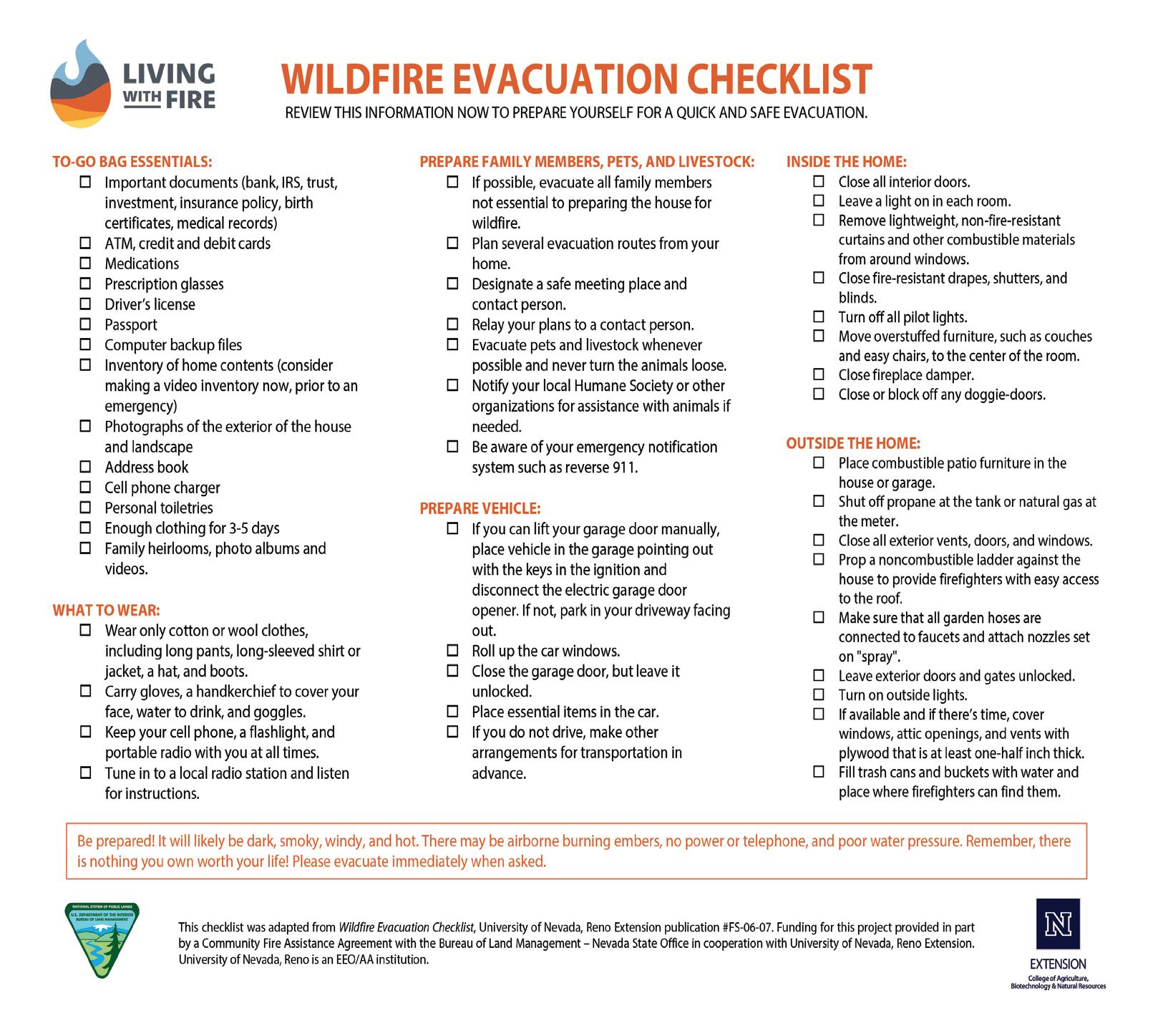



Prepare a wildfire Go Bag

If you were told to get ready for an evacuation or to evacuate immediately, do you have a Go Bag of essential items ready? If not, there’s no better time than right now to put yours together. A Go Bag should be prepared before an emergency, be easily accessible and filled with at least a three-day supply of items needed to help you quickly and safely evacuate your home.

ESSENTIALS INCLUDE:
• Clothing & personal toiletries
• Face masks or coverings
• Inventory of home contents & photographs/videotape of the house & landscape
• An inventory checklist from your insurance agent
• Flashlight, portable radio tuned to an emergency radio station & extra batteries changed annually
• Extra set of car & house keys
• Contact information for family, friends & physicians

• Cash & extra credit cards
• Medications & prescription glasses
• Water & non-perishable food
• First-Aid kit
• Pack a Pet Go Bag for each pet (see below)
• Important records – passports, birth certificates, titles, medical records, etc.
• Electronic chargers
• Paper map marked with Evacuation Routes (especially if you don’t live here full time)
OTHER ITEMS TO PACK:
• Hand sanitizer/wipes
• Books & magazines
• Games, cards & toys
• Trash bags
• Rain poncho
• Blankets
• Laundry detergent
• Rubber gloves
• Sleeping bag & tent
• Family heirlooms & photos
• Computers & hard drives
Always keep a sturdy pair of shoes and a flashlight near your bed and handy in case of a sudden evacuation at night.n

PREPARE A PET GO BAG

Pack several days of food, water & prescriptions for each pet along with:
• Leashes, harnesses & collars
• Toys & blankets
• Litter box, litter & scoop for cats
• Doggie bags
• Treats
WILDFIRE PREPAREDNESS GUIDE | TheTahoeWeekly.com 4
COURTESY TAHOE FIRE & FUELS TEAM & CAL FIRE
TAHOE WEEKLY’S WILDFIRE PREPAREDNESS GUIDE
SPONSORS
Does your home have defensible space?
DEFENSIBLE SPACE RESOURCES
California Cooperative Extension Offices | ucanr.edu
Chipping/mulch programs
| Contact local fire district; livingwithfire.com
Defensible Space Inspection
| Contact local fire district; tahoelivingwithfire.com
Living with Fire homeowner’s guide | trpa.gov
Native plants | naes.agnt.unr.edu
Nevada Cooperative Extension Offices | ucanr.edu
Tree removal | trpa.gov
If a wildfire breaks out, will firefighters be able to save your home? Having defensible space around your home will mean the difference between whether firefighters can save your home or not.

The term defensible space refers to the area between a house and an oncoming wildfire where the vegetation has been managed to reduce the wildfire threat and allow firefighters to safely defend the house. In the event that firefighters are not available, defensible space also improves the likelihood of a home surviving without assistance.
DEFENSIBLE SPACE ZONE
The size of the defensible space is usually expressed as a distance extending outward from the house in all directions. The recommended distance is not the same for every home. It varies depending on the dominant vegetation surrounding the home and steepness of slope.
Once the recommended distance for defensible space is known, mark it by tying strips of cloth or flagging to shrubs. This becomes the Defensible Space Zone.
If the Defensible Space Zone exceeds your property boundaries, talk to neighbors about creating defensible space and offer to help with the work. It is important to note that the effectiveness of the Defensible Space Zone improves when entire neighborhoods implement defensible space practices.
REMOVE DEAD VEGETATION, DEBRIS
Remove dead and dying vegetation including:
• Dead and dying trees.
• Dead native and ornamental shrubs.
• Dead branches.
• Dried grass, weeds and flowers.
• Exposed branches from fallen trees that are embedded into the ground.
FOR FALLEN PINE NEEDLES & LEAVES
• Within 5 feet of the house, remove routinely throughout fire season.
• From 5 feet to 30 feet of the house, remove every spring.
• More than 30 feet from the house, do not allow fallen needles and leaves to exceed a depth of 3 inches.
THIN NATIVE VEGETATION
Within the Defensible Space Zone, native trees and shrubs (Jeffrey pine, white fir and manzanita) should not occur in dense stands. Dense stands of trees and shrubs pose a significant wildfire threat.
Within 30 feet of the house, the canopies of individual or small groups of several trees should be separated by 10 feet to 30 feet. Contact local fire professionals or TRPA to have trees evaluated and marked for removal.
REMOVE LADDER FUEL
Vegetation that can carry a fire from low-growing plants to taller plants is called ladder fuel. In areas where trees
have been thinned as noted above, lower tree branches should be removed to a height of at least 10 feet. Shrubs and trees growing under the drip line should also be removed.
Irrigated, well-maintained lawns and flower beds, as well as low-growing ground covers can be present under the tree’s drip line if it would not allow a fire to ignite the tree. Removal of tree branches should not exceed one third of the total tree height. Removing more than this can be detrimental to tree health. For tips on proper tree pruning, contact a Cooperative Extension office.
LEAN, CLEAN & GREEN AREA
Create a Lean, Clean and Green Area extending 5 to 30 feet from the house. The first goal is to eliminate easily ignitable fuels, or kindling, near the house. This will help prevent embers from starting a fire in a yard. The second goal is to keep fire intensity low if it does ignite near the house.
• Remove dead and drying vegetation and debris regularly.
• Wood and bark mulches can be used in this area, but not in a widespread manner and areas should separated by noncombustible materials.
• Native shrubs should be substantially reduced in this area. Individual specimens or small groups can be retained as long as they are kept healthy and vigorous, pruned and would not allow a fire to travel rapidly across the area.
• Use low-growing (less than 18 inches
tall), irrigated, herbaceous plants, such as lawn, clover, erosion-control grasses, flowers, some ground covers and succulents, that are recommended for the area.
• Ornamental, deciduous trees and shrubs can be used as specimens or in small groups. They should be irrigated, kept healthy and vigorous, free of dead leaves and wood, and arranged so that they could not rapidly transmit fire.
• Ornamental evergreen shrubs and trees such as juniper, mugo pine, Austrian pine and others, should not be used within this area.
• Clear all flammable vegetation from within 10 feet of a propane tank.
• Remove tree limbs that are within 10 feet of a chimney, house, deck and roof. Remove limbs that are encroaching on power lines.
NONCOMBUSTIBLE AREA
Create a Noncombustible Area at least 5 feet wide around the base of the house. It should consist of noncombustible landscape materials and ignition-resistant, low-volume plants.
MAINTAIN DEFENSIBLE SPACE ZONE
Maintaining a defensible space is an ongoing activity. Plants grow back and flammable vegetation needs to be routinely removed and disposed of properly. | trpa.gov n
2023 | WILDFIRE PREPAREDNESS GUIDE 5 COURTESY TRPA
Courtesy UNR Cooperative Extension
Understand fire warnings, Red Flags
EVACUATION ROUTES & EMERGENCY PREPAREDNESS GUIDES
Alpine County | alpinecountyca.gov
Incline Village & Crystal Bay | nltfpd.org
North Lake Tahoe & West Shore | bit.ly/3CRDgtG
Olympic Valley | ovpsd.org
South Lake Tahoe area | southtahoeemergencyguide.com

Tahoe Donner | tahoedonner.com
Truckee | truckeefire.org
Hard copies available at local fire districts
SIGN UP FOR EMERGENCY ALERTS
Alpine County | alpinecountyca.gov
City of South Lake Tahoe | cityofslt.us
Douglas County | douglascountynv. gov
El Dorado County | ready.edso.org
Nevada County | mynevadacounty. com
Placer County | placer.ca.gov
Town of Truckee | truckeepolice.com

Washoe County | washoecounty.gov

One of the first steps to being prepared for a wildfire is to understand what wildfire warnings and alerts mean.
Issued by different agencies, sometimes wildfire alert terminology can be confusing. Do you know the difference between a Fire Weather Watch and a Red Flag Warning? What about the difference between an evacuation warning and an evacuation order?
RED FLAG WARNING
The National Weather Service issues Red Flag Warnings during weather conditions that could lead to extreme fire behavior within the next 24 hours. Such conditions include high and sustained wind speeds (averaging 15 mph or greater), low relative humidity (25 percent or less) and temperatures greater than 75 degrees. During these events, extreme caution is advised. All sources of outdoor flames are prohibited during Red Flag days, including propane and charcoal.
FIRE WEATHER WATCH
The National Weather Service issues a Fire Weather Watch 12 to 72 hours in advance of hazardous weather condi-
tions. It means critical fire weather is possible but not imminent or occurring. The watch remains in effect until it expires, is canceled, or upgraded to a Red Flag Warning.
Both Red Flag Warnings and Fire Weather Watches call for extreme caution. Stay up to date with local fire district’s seasonal restrictions and never use fire when and where it’s not allowed.
WILDFIRE EVACUATION ALERTS
If a wildfire ignited during a Red Flag Warning or a Fire Weather Watch, you should know the correct evacuation terminology in case the fire is life-threatening.
Issued by local law enforcement, evacuation orders and evacuation warnings both suggest a threat to life and property, although they are slightly different.
Evacuation Order | An evacuation order is mandatory. It suggests there is an immediate threat to life, and it is a lawful order to leave. When this type of order is issued, everyone in the given evacuation zone must exit as the zone will be legally closed to the public until further notice.
Never ignore an evacuation order.
Doing so puts not only your life at risk, but also the lives of law enforcement and fire personnel.
Evacuation Warning | An evacuation warning suggests a potential threat to life. Evacuation isn’t mandatory at this point, although it is advised and preparation is necessary.
Those who require additional time to evacuate (such as elderly, disabled and large families with pets and livestock) should leave during a warning. In many instances, evacuation warnings quickly become evacuation orders. | tahoelivingwithfire.com n
T AHOE L IVING W ITH F IRE . COM
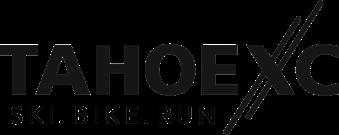
• Check current fire conditions & Red Flag warnings
• Find fire districts around Lake Tahoe
• Find tips for being prepared

WILDFIRE PREPAREDNESS GUIDE | TheTahoeWeekly.com 6
TAHOE WEEKLY’S WILDFIRE PREPAREDNESS GUIDE SPONSORS
FROM TAHOE NETWORK OF FIRE ADAPTED COMMUNITIES
Courtesy Network of Fire Adapted Communities
RESOURCES
Cal Fire | readyforwildfire.org
Chipping programs | Contact local fire district
Create a disaster kit | redcross.org
Create a home wildfire checklist | readyforwildfire.org
Current fire conditions & restrictions | tahoelivingwithfire.com
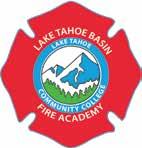
Nevada Fire Info | nevadafireinfo.org

Placer County Fire Safe Alliance | placer.ca.gov
Prepare for a disaster | tahoelivingwithfire.com/get-prepared
Truckee Travel Alert | visittruckeetahoe.com
Wildfire camera network | alertwildfire.org
Wildfire Evacuation Checklist | livingwithfire.com
Un Kit De Suministros De Emergencia | readyforwildfire.org
TIPS FOR SURVIVING A WILDFIRE IF YOU’RE TRAPPED
Courtesy Cal Fire
IN A VEHICLE
Stay calm.
Park your vehicle in an area clear of vegetation.
Close all vehicle windows & vents. Cover yourself with wool blanket or jacket.
Lie on vehicle floor.
Call 911.
ON FOOT
Stay calm.
Go to an area clear of vegetation, a ditch or depression on level ground if possible.
Lie face down, cover up your body.
Call 911.
AT HOME
Stay calm, keep your family together.
Call 911 & inform authorities of your location.
Fill sinks & tubs with cold water. Keep doors and windows closed but unlocked.
Stay inside your house.
Stay away from outside walls & windows.
READING, PANEL TALK ON CLIMATE & WILDFIRE

University of Nevada, Reno at Lake Tahoe will present a book reading and panel talk in Prim Library in Incline Village, Nev., on June 10 on wildfire and climate change. This one-day event would look at the subject from the viewpoint of Clare Frank, the first and only female Chief of Fire Protection for CAL FIRE. She will be reading from her book, “Burnt: A Memoir of Fighting Fire” from 1 to 2 p.m.

The reading will be followed by a panel of experts moderated by the Climate and Wildfire Institute from 2:30 to 3:30 p.m. The panel will examine the science behind the climate realities and the necessary responses to address this crisis facing the American West and beyond. Admission is free to both. | events.unr.edu
BOOK BY CAL FIRE’S ONLY FEMALE CHIEF
Clare Frank started firefighting in California at age 17 (she lied about her age on her application) and was promoted up the ranks to become the state’s first and only female Chief of Fire Protection. Along the way, she earned a BS in fire administration, an MFA in creative writing and a JD. She has lectured at colleges, universities and state and national fire conferences.
Her book is an inspiring, richly detailed and open-hearted account of an extraordinary life in fire. It chronicles the transformation of a young adult determined to prove her mettle into a scarred and sensitive veteran, grappling with the weight of her duties while record-setting fires engulfed her home state. Frank lives near Lake Tahoe with her husband and two dogs. This, her first book, is available from Abrams Press. | therealclarefrank.com
BOOK LAUNCH
May 26 | 4-6 p.m. | Word After Word Bookstore, Truckee
June 8 | 6 p.m. | Sundance Books & Music, Reno, Nev.
June 10 | 1-2 p.m. | UNR at Lake Tahoe, Incline Village, Nev.


July 13 | 5:30 p.m. | Community of Writers, Olympic Valley
Aug. 12 | 7 p.m. | UNR at Lake Tahoe, Incline Village, Nev.
Proud to support the neighborhood
Being a good neighbor means being there for my community. As your local State Farm® agent, I’m ready to help whenever you need me. Give me a call. Start your Wildfire Preparedness today! We are all in this together.
Roxanne Duffield Ins Agcy Inc
Roxanne Duffield Ins Agcy Inc | Agent 10775 Pioneer Trail suite #211C, Truckee, CA 96161 Bus: 530-550-9000

2023 | WILDFIRE PREPAREDNESS GUIDE 7
TAHOE’S COFFEE® A L P E N SIERRA CO F FEE ROASTIN G C .O mountain roasted ® since 1991 State Farm Bloomington, IL Start your Wildfire Preparedness today! We are all in this together. Being a good neighbor means being there for my community. As your local State Farm® agent, I'm ready to help whenever you need me. Give me a call. Proud to support the neighborhood Agent 10775 Pioneer Trail suite #211C Truckee, CA 96161 Bus: 530-550-9000 www.insuranceroxanne.com
insuranceroxanne.com Insurance License #0L53516
Insurance License #0L53516 State Farm | Bloomington, IL Caldor Fire
www.insuranceroxanne.com insuranceroxanne.com
| Calfire Caldor Fire | Calfire
home like hail during a storm. If these embers become lodged in something easily ignited on or near your house, the home will be in jeopardy of burning. Common materials that become embers during wildfire include pine cones, branches, tree bark and wooden shingles. Depending on fire intensity, wind speed and the size of materials that are burning, embers can be carried more than a mile ahead of the fire. Consequently, even homes located blocks away from the flame front are vulnerable to ignition and complete destruction.
By being ember aware and taking action ahead of time, a homeowner can substan-tially reduce the ember threat.

1.WOOD ROOF Replace wood shake and shingle roofs with fire-resistant types
2.ROOF OPENINGS Plug openings in roof coverings such as the open ends of barrel tiles, with non-combustible materials.
3.ROOF DEBRIS Routinely remove plant debris such as pine needles, leaves, branches and bark, from the roof.
4.SKYLIGHTS Replace plastic skylights with types constructed of double-pane glass. One of the panes should be tempered glass. Close skylights if wildfire is threatening.
5.SPARK ARRESTER Install an approved spark arrester on chimneys.
6.WINDOWS Replace single-pane, non-tempered glass windows with multiple-pane, tempered-glass types. Close all windows if wildfire is threatening.
7.VENTS Cover attic, eave and foundation vents with 1/8-inch wire mesh or install new vent types designed to prevent ember entry. If wildfire is threatening, consider covering vent openings.
8.RAIN GUTTERS Keep rain gutters free of debris. Consider using rain gutter covers to reduce maintenance.
9.SIDING Fill gaps in siding and trim materials with a caulk and replace poor condition building materials.
10.WOODPILES Move firewood stacks and scrap lumber piles at least 30 feet from any structures.
11.PATIO FURNITURE Place combustible patio furniture such as lounges, tables and hammocks inside the house or garage if wildfire is threatening.
12.DECK BOARDS Replace deck boards that are less than 1-inch thick or that are in poor condition with thicker, good condition boards. Use metal flashing between the deck and the house.
13.DECK DEBRIS Remove plant debris from the gaps between deck boards, the gap between the deck and house, and lying on top of the deck.
14.PORCH & DECK ACCESSORIES If wildfire is threatening, remove combustible materials from the porch and deck including newspapers, wicker baskets, door mats, pine cones and dried flower arrangements, and place BBQ propane tanks indoors.
15. UNDER THE DECK Remove plant debris, wood piles and other easily ignited materials from under decks. Consider enclosing the open sides of the deck with siding materials that are properly vented or 1/8-inch wire mesh to reduce maintenance and deter ember entry. Do not use wooden lattice.
16.FLOWERBOXES Remove wooden flowerboxes from beneath windows if wildfire is threatening.
17. EAVES Cover open eaves with sheathing such as plywood or fiber-cement board. Use tongue and groove joints or other intricate joint types and don’t use butt joints.
18.FLOWERBEDS Replace wood mulches with noncombustible types and remove plant debris, including dried grass and flowers, dead leaves and dead branches from flowerbeds. Replace ornamental junipers with low-growing deciduous shrubs or flowers under irrigation.
19.VEHICLES Close vehicle windows. Back into the garage and close the garage door or park away from the house.
20.GARAGE DOOR Adjust garage doors to achieve as tight as fit as possible with the door frame. Consider using trim around the garage door opening to reduce gap openings. Close the garage door if wildfire is threatening.
21.GARBAGE CANS & RECYCLING BINS
Use garbage cans covered with tight fitting lids near the house or other buildings. Move newspaper recycling bins indoors.
22.WOODEN FENCES Maintain wooden fences in good condition and create a noncombustible fence section or gate next to the house for at least 5 feet.
WILDFIRE PREPAREDNESS GUIDE | TheTahoeWeekly.com 8
COURTESY UNR COOPERATIVE EXTENSION
Is your home ready for a disaster?
Preparing your home for a natural disaster or fire, includes checking that your insurance coverage is adequate and creating a home inventory. Keep a copy of your home inventory in a firebox and with your Go Bag.
CHECK INSURANCE COVERAGE
Check your policy limits and coverage annually and make sure the policy reflects the correct square footage, features in the home and any recent improvements. Consider purchasing building code upgrade coverage. Keep a list of insurance contacts and policy details in your Go Bag.
What’s covered | The details matter. Understand if you have a replacement cost policy that pays to replace all your items at current market price or an actual cash value policy that takes depreciation into account and pays less for aged items.
Home improvements | If you make home improvements, be sure to update your coverage including for new countertops, floors, etc.
Maintain insurance | If your home is paid off, be sure to maintain homeowner’s insurance. Without insurance, you likely won’t have the funds to rebuild. Renters insurance | Renters can lose
everything in a fire and be left to start over. Many insurers bundle coverage with an auto insurance policy at affordable prices.
PREPARE A HOME INVENTORY

Filing insurance claims will be easier if you have an accurate home inventory by documenting the contents of your home. Use a smartphone to make a video of your belongings, including vehicles and equipment. Keep the inventory and
photos outside the home or stored in the cloud.
Make an inventory | Video or photograph each room of the home. Remember to document drawers and closets. Don’t forget the garage and sheds. Download a Home Inventory Checklist from the National Association of Insurance Commissioners or download the app to make one on a phone Document value | Keep a record or video of prices of items and where and
CHIPPING &
DEFENSIBLE
(through local fire departments)
when you purchased them. Make note of important or expensive items like electronics, appliances, sports equipment, TVs, computers, jewelry, etc. Save receipts | Save receipts for all major purchases and store in the cloud or a fireproof case. | ready.gov/plan, readyforwildfire.org n
Download a Home Inventory Checklist at: naic.org
Martis Fire | Mike Vollmeer
WILDFIRE HOME RETROFIT GUIDE
Courtesy Tahoe Resource Conservation District
A team of California and Nevada scientists and practitioners has published the Wildfire Home Retrofit Guide, available for free download, with recommendations to retrofit homes.

During a wildfire, 60 to 90 percent of home loss is due to embers. Depending on a fire’s intensity and wind speed, embers can travel more than a mile ahead of a flame front. Thus, even a home blocks away from a fire can be at risk of ignition. The Wildfire Home Retrofit Guide recommends a coupled approach that considers both the vegetation surrounding a home and the home’s construction materials. It includes recommendations for ember-vulnerable components of a home including roofs, rain gutters, eaves, vents, siding, skylights, windows, decks, chimneys and fences. These recommendations range from routine maintenance (removing pine needles from roofs and gutters), to DIY projects (installing 1/8thinch metal mesh screening to vents), to full retrofits (replacing a wood-shake roof). | tahoelivingwithfire.com
SPACE
INSPECTIONS
East Shore (Tahoe Douglas Fire) | (775) 588-3591, tahoefire.org
Fallen Leaf Fire | (530) 544-3300, fllcsd.org
Incline Village & Crystal Bay (North Lake Tahoe Fire) | nltfpd.org
Meyers (Lake Valley Fire) | (530) 577-2447, lakevalleyfire.org
North & West Shores (North Tahoe Fire) | (530) 584-2322, ntfire.net
Northstar Fire | (530) 562-1212, northstarcsd.org
Olympic Valley Fire | (530) 583-4692, ovpsd.org
South Lake Tahoe Fire | (530) 542-6037, cityofslt.us
Truckee Fire | truckeefire.org/dspace
REPORT VEGETATION CONCERNS
California Tahoe Conservancy lands | (530) 542-5580, tahoe.ca.gov
U.S. Forest Service, Lake Tahoe Basin lands | (530) 543-2759

2023 | WILDFIRE PREPAREDNESS GUIDE 9
COURTESY CAL FIRE & FEMA
WILDFIRE PREPAREDNESS GUIDE | TheTahoeWeekly.com 10 CalFire
Have a paper copy posted at home and keep a copy in your Go Bag as electricity, the internet and cell phones may be inoperable during a disaster. Also available at TheTahoeWeekly.com or issuu.com/TheTahoeWeekly.com.
Write
2023 | WILDFIRE PREPAREDNESS GUIDE 11 IN CASE OF EMERGENCY (ICE) CONTACT Name: M obile #: Home #: Email: Address: OUT-OF-TOWN CONTACT Name: M obile #: Home #: Email: Address: EMERGENCY MEETING PLACES Indoor: Instructions: N eighborhood: Instructions: Out-of-Neighborhood: Address: Instructions: Out-of-Town: Address: Instructions: IMPORTANT NUMBERS OR INFORMATION Police: Dial 911 or #: Fire: Dial 911 or #: Poison Control: #: Doctor: #: Doctor: #: Pediatrician: #: Dentist: #: Medical Insurance: # : Policy #: Medical Insurance: #: Policy #: Hospital/Clinic: #: Pharmacy: #: Homeowner/Rental Insurance: #: Policy #: Flood Insurance: #: Policy #: Veterinarian: #: Kennel: #: Electric Company: #: Gas Company: #: Water Company: #: Alternate/Accessible Transportation: #: Other: Other: LEARN MORE AT ready.gov/prepare IN CASE OF EMERGENCY (ICE) CONTACT Name: M obile #: Home #: Email: Address: OUT-OF-TOWN CONTACT Name: M obile #: Home #: Email: Address: EMERGENCY MEETING PLACES Indoor: Instructions: N eighborhood: Instructions: O ut-of-Neighborhood: Address: Instructions: Out-of-Town: Address: Instructions: IMPORTANT NUMBERS OR INFORMATION Police: Dial 911 or #: Fire: Dial 911 or #: Poison Control: #: Doctor: #: Doctor: #: Pediatrician: #: Dentist: #: Medical Insurance: # : Policy #: Medical Insurance: #: Policy #: Hospital/Clinic: #: Pharmacy: #: Homeowner/Rental Insurance: #: Policy #: Flood Insurance: #: Policy #: Veterinarian: #: Kennel: #: Electric Company: #: Gas Company: #: Water Company: #: Alternate/Accessible Transportation: #: Other: Other:
Family Emergency Communication Plan
HOUSEHOLD INFORMATION Home #: Address: N ame: Mobile #: O ther # or social media: Email: Important medical or other information: Name: Mobile #: O ther # or social media: Email: Important medical or other information Name: Mobile #: Other # or social media: Email: Important medical or other information: Name: Mobile #: Other # or social media: Email: Important medical or other information: SCHOOL, CHILDCARE , CAREGIVER, AND WORKPLACE EMERGENCY PLANS N ame: Address: Emergency/Hotline #: Website: Emergency Plan/Pick-Up: Name: Address: Emergency/Hotline # : Website: Emergency Plan/Pick-Up: Name: Address: Emergency/Hotline #: Website: Emergency Plan/Pick-Up: Name: Address: Emergency/Hotline #: Website: Emergency Plan/Pick-Up: provided courtesy of
your family’s name above FEMA P-1095/July 2017
Create a disaster survival kit
Onceyou can return to your home after an evacuation or after a disaster, you’ll need food and supplies on hand as power, water and gas may be out for extended periods of time and there may be limited resources, like food, available. You should also keep a kit prepared for winter disasters. – KATHERINE E.
HILL
BASIC SUPPLIES
• Water. 1 gallon per person, per day, 2-week supply. Include water for pets.
• Food. 2-week supply of non-perishable, easy-toprepare items.

Manual can opener if using canned items.
• Portable gas stove with extra canisters
• Flashlight
• Battery-powered, solar or hand-cranked radio
• Extra batteries
• First aid kit
• Know CPR. Take a class, if needed. Visit redcross. org.
• Medications & medical supplies. 2-week supply including hearing aid batteries, glasses, syringes, etc.
• Baby supplies. Bottles and 2-week supply of formula, baby food, diapers, etc.
• Multi-purpose tool
• Sanitation & personal hygiene items
• Extra cash
• Copies of personal documents (medication list and pertinent medical information, proof of address, deed/lease to home, passports, birth certificates, insurance policies)
• Cell phone with chargers, including a solar or battery-operated charger
• Family & emergency contact information (paper copy)
• Emergency blankets or sleeping bags
• Paper maps of the area
• Games & activities for children
• Pet supplies with 2 weeks of food
• Two-way radios
• Extra set of car & house keys
• Whistle
• Face masks
• Matches in a waterproof container
• Rain gear
• Towels
• Work gloves
• Tools & supplies for securing your home
• Extra clothing, hat & sturdy shoes
• Plastic sheeting
• Duct tape
• Scissors
• Household liquid bleach
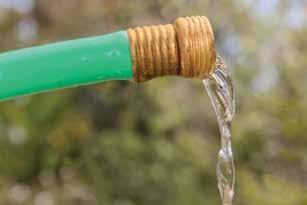
• Fire extinguisher (know how to use it)
• Disposable paper plates, cups & utensils (biodegradable preferred)
• Moist towelettes, garbage bags & plastic ties for personal sanitation
• Non-sparking wrench & pliers for turning off utilities
• Locate all utilities shut offs in advance and know how to turn them off
MAKE A FIRST AID KIT

(For a family of 4)
• Required medications & medical supplies for family members
• 2 absorbent compress dressings (5 x 9 inches)
• 25 adhesive bandages (assorted sizes)
• 1 adhesive cloth tape (10 yards x 1 inch)
• 5 antibiotic ointment packets
• 5 antiseptic wipe packets
• 2 packets of aspirin (81 mg each)
• 1 emergency blanket
• 1 breathing barrier (with one-way valve)
• 1 instant cold compress
• 2 pair of nonlatex gloves (size to fit adults)
• 2 hydrocortisone ointment packets
• 1 3 in. gauze roll (roller) bandage
• 1 roller bandage (4 inches wide)
• 5 3 in. x 3 in. sterile gauze pads
• 5 sterile gauze pads (4 x 4 inches)
• Oral thermometer (non-mercury/nonglass)
• 2 triangular bandages
• Tweezers
• Emergency First Aid guide (paper)
Check the kit regularly & replace expired items.
Always keep a sturdy pair of shoes and a flashlight near your bed and handy in case of a sudden evacuation at night.
Preserve water for firefighters
Water
purveyors around Lake Tahoe are reporting an alarming trend of residents leaving irrigation, garden hoses and sprinklers on roofs actively running when they evacuate their homes. Not only is this not helpful in protecting homes from wildfire, but it can be detrimental for firefighters who rely on a water supply with adequate water flow to fight fire in extremely dangerous conditions, according to a press release from North Tahoe Fire Protection District. As a result, Lake Tahoe utility districts and water purveyors are exper-iencing a huge draw-down in water supplies and wells are pumping at maximum capacity throughout the area, even in evacuated areas that should be empty of residents. This can leave tanks dangerously low when firefighters need fast access to water from fire hydrants to protect homes.
Residents are also calling fire districts to ask if they should spray down roofs and vegetation before evacuating. This is not effective, as the roof will dry quickly, as will the vegetation, which doesn’t protect the home itself. Wide-scale activation of sprinklers and garden hoses dramatically reduces water pressure in the entire region. Evacuation preparedness efforts are better spent on removing combustible material away from homes. | Resources tahoelivingwithfire.com n
WILDFIRE PREPAREDNESS GUIDE | TheTahoeWeekly.com 12 COURTESY
AMERICAN RED CROSS & FEMA
WE HAVE EVACUATED
ALL occupants evacuated on:

Adult:
Adult:
Child:
Child:
Pets:
Others: CONTACT INFO:








Evacuated to:


Emergency contacts:
Vehicle driven:
License plate:
Vehicle driven:
License plate:
COURTESY Design
E.
post where visible for rescue personnel if you need to evacuate.
Katherine
Hill & Alyssa Ganong | Tahoe Weekly Please
















































